High Spatial Resolution Nighttime PM2.5 Datasets in the Beijing–Tianjin–Hebei Region from 2015 to 2021 Using VIIRS/DNB and Deep Learning Model
Abstract
:1. Introduction
2. Materials and Methods
2.1. Materials
2.1.1. Ground PM2.5 Data
2.1.2. Satellite Data
2.1.3. Meteorological Data
2.1.4. Auxiliary Data
2.2. Methods
2.2.1. Deep Neural Network (DNN) Model
2.2.2. Model Evaluation Methods
3. Results
3.1. Model Performance
3.1.1. Accuracy of Models
3.1.2. Spatial Performance
3.1.3. Influence of Input Factors
3.2. Spatial Distribution Characteristics
3.3. Applications in Different Scenarios
4. Discussion
5. Conclusions
- (1)
- Studies have shown that the proposed model outperforms most existing models, including MLR, BP, and SVM, in terms of time coverage and spatial resolution. Among them, the R2 of the 2015–2021 model is 0.56, 0.55, 0.51, 0.53, 0.58, 0.68, and 0.63, respectively. Cross-validation based on samples, sites, and leaving one city showed that the models in this study had better spatial performance. The method of circularly removing each input variable showed that the input variables used in this study had an impact on the estimation of PM2.5 and that the model performed best when all input variables were used.
- (2)
- This study produced a map of nighttime PM2.5 concentrations for 2015–2021, which exhibited a yearly decrease. The lowest PM2.5 was recorded in summer, followed by spring and autumn, with the highest levels recorded in winter. Higher pollution levels were observed in the central and eastern parts of the BTH region, whereas lower levels were observed in the northwest region.
- (3)
- A comparison of daytime and nighttime PM2.5, shows that there is a large difference in PM2.5 concentrations between day and night, indicating that nighttime PM2.5 concentration monitoring is meaningful, and the production of nighttime PM2.5 provides the possibility of continuous monitoring day and night. Simultaneously, nighttime PM2.5 provided data support for short-term surge events and environmental pollution monitoring, such as setting off fireworks during the Spring Festival and excessive emissions from the Tangshan Iron and Steel Plant.
Supplementary Materials
Author Contributions
Funding
Data Availability Statement
Conflicts of Interest
References
- Guo, B.; Zhang, D.; Pei, L.; Su, Y.; Wang, X.; Bian, Y.; Zhang, D.; Yao, W.; Zhou, Z.; Guo, L. Estimating PM(2.5) concentrations via random forest method using satellite, auxiliary, and ground-level station dataset at multiple temporal scales across China in 2017. Sci. Total Environ. 2021, 778, 146288. [Google Scholar] [CrossRef]
- Zhang, Y.; Zhu, B.; Gao, J.; Kang, H.; Yang, P.; Wang, L.; Zhang, J. The Source Apportionment of Primary PM2.5 in an Aerosol Pollution Event over Beijing-Tianjin-Hebei Region using WRF-Chem, China. Aerosol Air Qual. Res. 2017, 17, 2966–2980. [Google Scholar] [CrossRef]
- Choi, H.; Park, S.; Kang, Y.; Im, J.; Song, S. Retrieval of hourly PM(2.5) using top-of-atmosphere reflectance from geostationary ocean color imagers I and II. Environ. Pollut. 2023, 323, 121169. [Google Scholar] [CrossRef]
- Feng, Y.; Fan, S.; Xia, K.; Wang, L. Estimation of Regional Ground-Level PM2.5 Concentrations Directly from Satellite Top-of-Atmosphere Reflectance Using A Hybrid Learning Model. Remote Sens. 2022, 14, 2714. [Google Scholar] [CrossRef]
- Liu, N.; Li, S.; Zhang, F. Multi-Scale Spatiotemporal Variations and Drivers of PM2.5 in Beijing-Tianjin-Hebei from 2015 to 2020. Atmosphere 2022, 13, 1993. [Google Scholar] [CrossRef]
- Peng, J.; Han, H.; Yi, Y.; Huang, H.; Xie, L. Machine learning and deep learning modeling and simulation for predicting PM2.5 concentrations. Chemosphere 2022, 308, 136353. [Google Scholar] [CrossRef]
- Zhang, L.; Wilson, J.P.; Zhao, N.; Zhang, W.; Wu, Y. The dynamics of cardiovascular and respiratory deaths attributed to long-term PM(2.5) exposures in global megacities. Sci. Total Environ. 2022, 842, 156951. [Google Scholar] [CrossRef]
- Li, R.; Liu, X.; Li, X. Estimation of the PM2.5 Pollution Levels in Beijing Based on Nighttime Light Data from the Defense Meteorological Satellite Program-Operational Linescan System. Atmosphere 2015, 6, 607–622. [Google Scholar] [CrossRef]
- Ma, Y.; Zhang, W.; Zhang, L.; Gu, X.; Yu, T. Estimation of Ground-Level PM2. 5 Concentration at Night in Beijing-Tianjin-Hebei Region with NPP/VIIRS Day/Night Band. Remote Sens. 2023, 15, 825. [Google Scholar] [CrossRef]
- Xu, Z.; Xia, X.; Liu, X.; Qian, Z. Combining DMSP/OLS Nighttime Light with Echo State Network for Prediction of Daily PM2.5 Average Concentrations in Shanghai, China. Atmosphere 2015, 6, 1507–1520. [Google Scholar] [CrossRef]
- Zhang, L.; Wilson, J.P.; MacDonald, B.; Zhang, W.; Yu, T. The changing PM2.5 dynamics of global megacities based on long-term remotely sensed observations. Environ. Int. 2020, 142, 105862. [Google Scholar] [CrossRef]
- Chen, H.; Xu, Y.; Zhong, S.; Mo, Y.; Zhu, S. Mapping nighttime PM2.5 concentrations in Nanjing, China based on NPP/VIIRS nighttime light data. Atmos. Environ. 2023, 303, 119767. [Google Scholar] [CrossRef]
- Zhao, X.; Shi, H.; Yu, H.; Yang, P. Inversion of nighttime PM2. 5 mass concentration in Beijing based on the VIIRS day-night band. Atmosphere 2016, 7, 136. [Google Scholar] [CrossRef]
- Wang, J.; Aegerter, C.; Xu, X.; Szykman, J.J. Potential application of VIIRS Day/Night Band for monitoring nighttime surface PM 2.5 air quality from space. Atmos. Environ. 2016, 124, 55–63. [Google Scholar] [CrossRef]
- Fu, D.; Xia, X.; Duan, M.; Zhang, X.; Li, X.; Wang, J.; Liu, J. Mapping nighttime PM2.5 from VIIRS DNB using a linear mixed-effect model. Atmos. Environ. 2018, 178, 214–222. [Google Scholar] [CrossRef]
- Nechaev, D.; Zhizhin, M.; Poyda, A.; Ghosh, T.; Hsu, F.-C.; Elvidge, C. Cross-Sensor Nighttime Lights Image Calibration for DMSP/OLS and SNPP/VIIRS with Residual U-Net. Remote Sens. 2021, 13, 5026. [Google Scholar] [CrossRef]
- Zhang, G.; Shi, Y.; Xu, M. Evaluation of LJ1-01 Nighttime Light Imagery for Estimating Monthly PM2.5 Concentration: A Comparison With NPP-VIIRS Nighttime Light Data. IEEE J. Sel. Top. Appl. Earth Obs. Remote Sens. 2020, 13, 3618–3632. [Google Scholar] [CrossRef]
- Wang, X.; Mu, X.; Yan, G. Quantitative Analysis of Aerosol Influence on Suomi-NPP VIIRS Nighttime Light in China. IEEE J. Sel. Top. Appl. Earth Obs. Remote Sens. 2020, 13, 3557–3568. [Google Scholar] [CrossRef]
- Miller, S.; Straka, W.; Mills, S.; Elvidge, C.; Lee, T.; Solbrig, J.; Walther, A.; Heidinger, A.; Weiss, S. Illuminating the Capabilities of the Suomi National Polar-Orbiting Partnership (NPP) Visible Infrared Imaging Radiometer Suite (VIIRS) Day/Night Band. Remote Sens. 2013, 5, 6717–6766. [Google Scholar] [CrossRef]
- Coleman, C.J.; Yeager, R.A.; Pond, Z.A.; Riggs, D.W.; Bhatnagar, A.; Arden Pope, C., 3rd. Mortality risk associated with greenness, air pollution, and physical activity in a representative U.S. cohort. Sci. Total Environ. 2022, 824, 153848. [Google Scholar] [CrossRef]
- Ma, Z.; Dey, S.; Christopher, S.; Liu, R.; Bi, J.; Balyan, P.; Liu, Y. A review of statistical methods used for developing large-scale and long-term PM2.5 models from satellite data. Remote Sens. Environ. 2022, 269, 112827. [Google Scholar] [CrossRef]
- Mousavi, S.E.; Amini, H.; Heydarpour, P.; Amini Chermahini, F.; Godderis, L. Air pollution, environmental chemicals, and smoking may trigger vitamin D deficiency: Evidence and potential mechanisms. Environ. Int. 2019, 122, 67–90. [Google Scholar] [CrossRef] [PubMed]
- Weichenthal, S.; Pinault, L.; Christidis, T.; Burnett, R.T.; Brook, J.R.; Chu, Y.; Crouse, D.L.; Erickson, A.C.; Hystad, P.; Li, C. How low can you go? Air pollution affects mortality at very low levels. Sci. Adv. 2022, 8, eabo3381. [Google Scholar] [CrossRef] [PubMed]
- Zhang, L.; Zhao, N.; Zhang, W.; Wilson, J.P. Changes in Long-Term PM2.5 Pollution in the Urban and Suburban Areas of China’s Three Largest Urban Agglomerations from 2000 to 2020. Remote Sens. 2022, 14, 1716. [Google Scholar] [CrossRef]
- Chen, G.; Li, S.; Knibbs, L.D.; Hamm, N.A.S.; Cao, W.; Li, T.; Guo, J.; Ren, H.; Abramson, M.J.; Guo, Y. A machine learning method to estimate PM(2.5) concentrations across China with remote sensing, meteorological and land use information. Sci. Total Environ. 2018, 636, 52–60. [Google Scholar] [CrossRef] [PubMed]
- Xie, R.; Sabel, C.E.; Lu, X.; Zhu, W.; Kan, H.; Nielsen, C.P.; Wang, H. Long-term trend and spatial pattern of PM(2.5) induced premature mortality in China. Environ. Int. 2016, 97, 180–186. [Google Scholar] [CrossRef]
- Geng, G.; Xiao, Q.; Liu, S.; Liu, X.; Cheng, J.; Zheng, Y.; Xue, T.; Tong, D.; Zheng, B.; Peng, Y. Tracking Air Pollution in China: Near Real-Time PM2.5 Retrievals from Multisource Data Fusion. Environ. Sci. Technol. 2021, 55, 12106–12115. [Google Scholar] [CrossRef]
- Xiao, Q.; Geng, G.; Liu, S.; Liu, J.; Meng, X.; Zhang, Q. Spatiotemporal continuous estimates of daily 1 km PM2.5 from 2000 to present under the Tracking Air Pollution in China (TAP) framework. Atmos. Chem. Phys. 2022, 22, 13229–13242. [Google Scholar] [CrossRef]
- Wei, J.; Li, Z.; Cribb, M.; Huang, W.; Xue, W.; Sun, L.; Guo, J.; Peng, Y.; Li, J.; Lyapustin, A.; et al. Improved 1 km resolution PM2.5 estimates across China using enhanced space–time extremely randomized trees. Atmos. Chem. Phys. 2020, 20, 3273–3289. [Google Scholar] [CrossRef]
- Wei, J.; Li, Z.; Lyapustin, A.; Sun, L.; Peng, Y.; Xue, W.; Su, T.; Cribb, M. Reconstructing 1-km-resolution high-quality PM2.5 data records from 2000 to 2018 in China: Spatiotemporal variations and policy implications. Remote Sens. Environ. 2021, 252, 112136. [Google Scholar] [CrossRef]
- Wu, J.; Yao, F.; Li, W.; Si, M. VIIRS-based remote sensing estimation of ground-level PM2.5 concentrations in Beijing–Tianjin–Hebei: A spatiotemporal statistical model. Remote Sens. Environ. 2016, 184, 316–328. [Google Scholar] [CrossRef]
- Wang, Z.; Román, M.O.; Kalb, V.L.; Miller, S.D.; Zhang, J.; Shrestha, R.M. Quantifying uncertainties in nighttime light retrievals from Suomi-NPP and NOAA-20 VIIRS Day/Night Band data. Remote Sens. Environ. 2021, 263, 112557. [Google Scholar] [CrossRef]
- Román, M.O.; Wang, Z.; Sun, Q.; Kalb, V.; Miller, S.D.; Molthan, A.; Schultz, L.; Bell, J.; Stokes, E.C.; Pandey, B.; et al. NASA’s Black Marble nighttime lights product suite. Remote Sens. Environ. 2018, 210, 113–143. [Google Scholar] [CrossRef]
- Hersbach, H.; Bell, B.; Berrisford, P.; Hirahara, S.; Horányi, A.; Muñoz-Sabater, J.; Nicolas, J.; Peubey, C.; Radu, R.; Schepers, D.; et al. The ERA5 global reanalysis. Q. J. R. Meteorol. Soc. 2020, 146, 1999–2049. [Google Scholar] [CrossRef]
- Liu, H.; Dong, L.; Yan, R.; Zhang, X.; Guo, C.; Liang, S.; Tu, J.; Feng, X.; Wang, X. Evaluation of near-surface wind speed climatology and long-term trend over China’s mainland region based on ERA5 reanalysis. Clim. Environ. Res. 2021, 26, 299–311. [Google Scholar]
- Sun, Y.; Yang, F.; Liu, M.; Li, Z.; Gong, X.; Wang, Y. Evaluation of the weighted mean temperature over China using multiple reanalysis data and radiosonde. Atmos. Res. 2023, 285, 106664. [Google Scholar] [CrossRef]
- Zuo, C.; Chen, J.; Zhang, Y.; Jiang, Y.; Liu, M.; Liu, H.; Zhao, W.; Yan, X. Evaluation of four meteorological reanalysis datasets for satellite-based PM2. 5 retrievals over China. Atmos. Environ. 2023, 305, 119795. [Google Scholar] [CrossRef]
- She, L.; Zhang, H.K.; Li, Z.; de Leeuw, G.; Huang, B. Himawari-8 Aerosol Optical Depth (AOD) Retrieval Using a Deep Neural Network Trained Using AERONET Observations. Remote Sens. 2020, 12, 4125. [Google Scholar] [CrossRef]
- Li, T.; Shen, H.; Yuan, Q.; Zhang, X.; Zhang, L. Estimating Ground-Level PM2.5 by Fusing Satellite and Station Observations: A Geo-Intelligent Deep Learning Approach. Geophys. Res. Lett. 2017, 44, 11985–11993. [Google Scholar] [CrossRef]
- Miller, S.D.; Turner, R.E. A dynamic lunar spectral irradiance data set for NPOESS/VIIRS day/night band nighttime environmental applications. IEEE Trans. Geosci. Remote Sens. 2009, 47, 2316–2329. [Google Scholar] [CrossRef]
- Guo, B.; Wu, H.; Pei, L.; Zhu, X.; Zhang, D.; Wang, Y.; Luo, P. Study on the spatiotemporal dynamic of ground-level ozone concentrations on multiple scales across China during the blue sky protection campaign. Environ. Int. 2022, 170, 107606. [Google Scholar] [CrossRef]
- Zhao, X.; Shi, H.; Yang, P.; Zhang, L.; Fang, X.; Liang, K. Inversion Algorithm of PM2.5 Air Quality Based on Nighttime Light Data from NPP-VIIRS. J. Remote Sens. 2017, 21, 291–299. [Google Scholar] [CrossRef]
- Li, K.; Liu, C.; Jiao, P. Estimating of Nighttime PM2.5 Concentrations in Shanghai Based on NPP/VIIRS Day_Night Band Data. Acta Sci. Circumstantiae 2019, 39, 1913–1922. [Google Scholar] [CrossRef]
- Erkin, N.; Simayi, M.; Ablat, X.; Yahefu, P.; Maimaiti, B. Predicting spatiotemporal variations of PM2.5 concentrations during spring festival for county-level cities in China using VIIRS-DNB data. Atmos. Environ. 2023, 294, 119484. [Google Scholar] [CrossRef]
- Ma, S.; Yan, W.; Huang, Y.-X.; Ai, W.-H.; Zhao, X. Vicarious calibration of S-NPP/VIIRS day–night band using deep convective clouds. Remote Sens. Environ. 2015, 158, 42–55. [Google Scholar] [CrossRef]
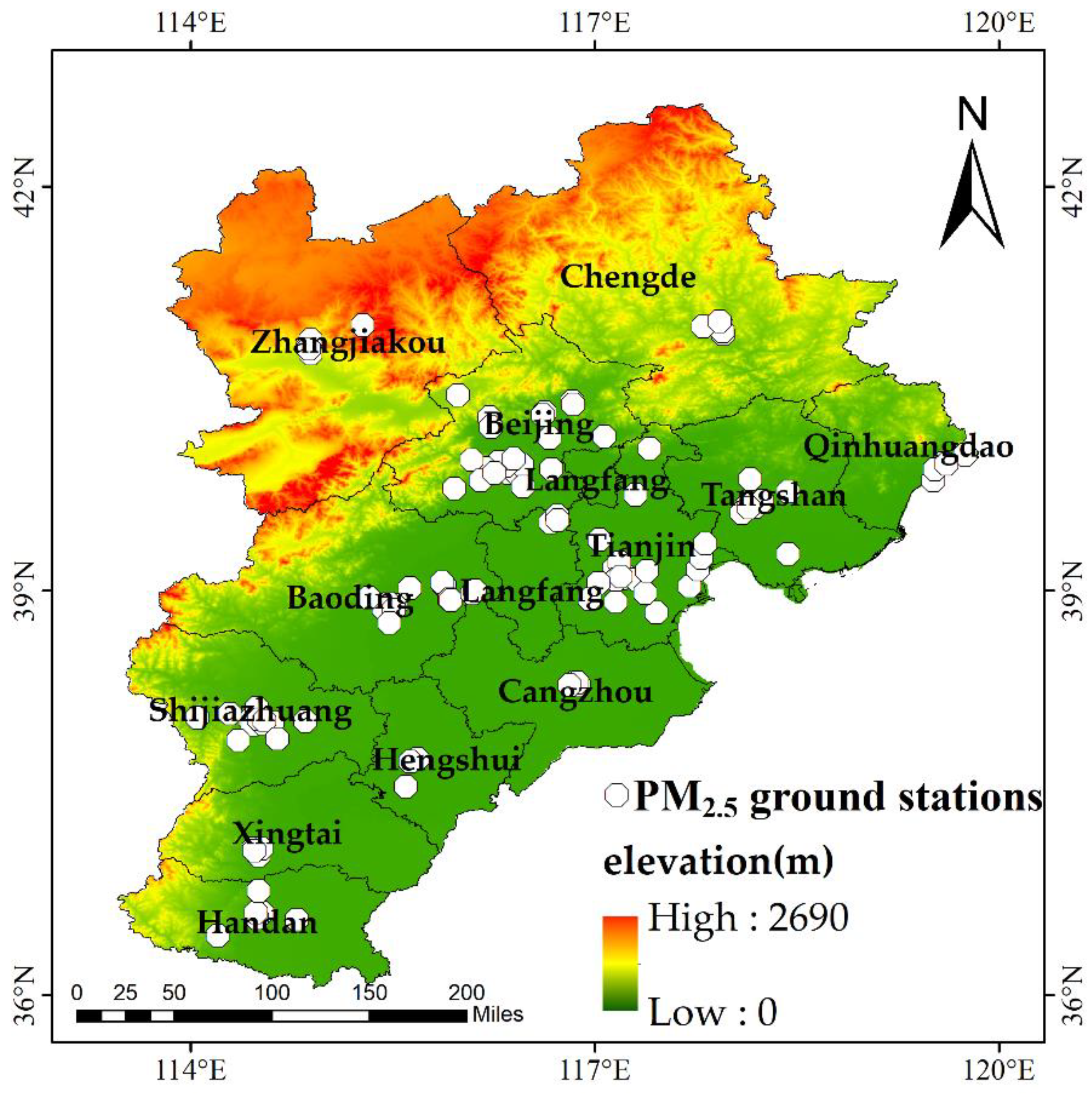
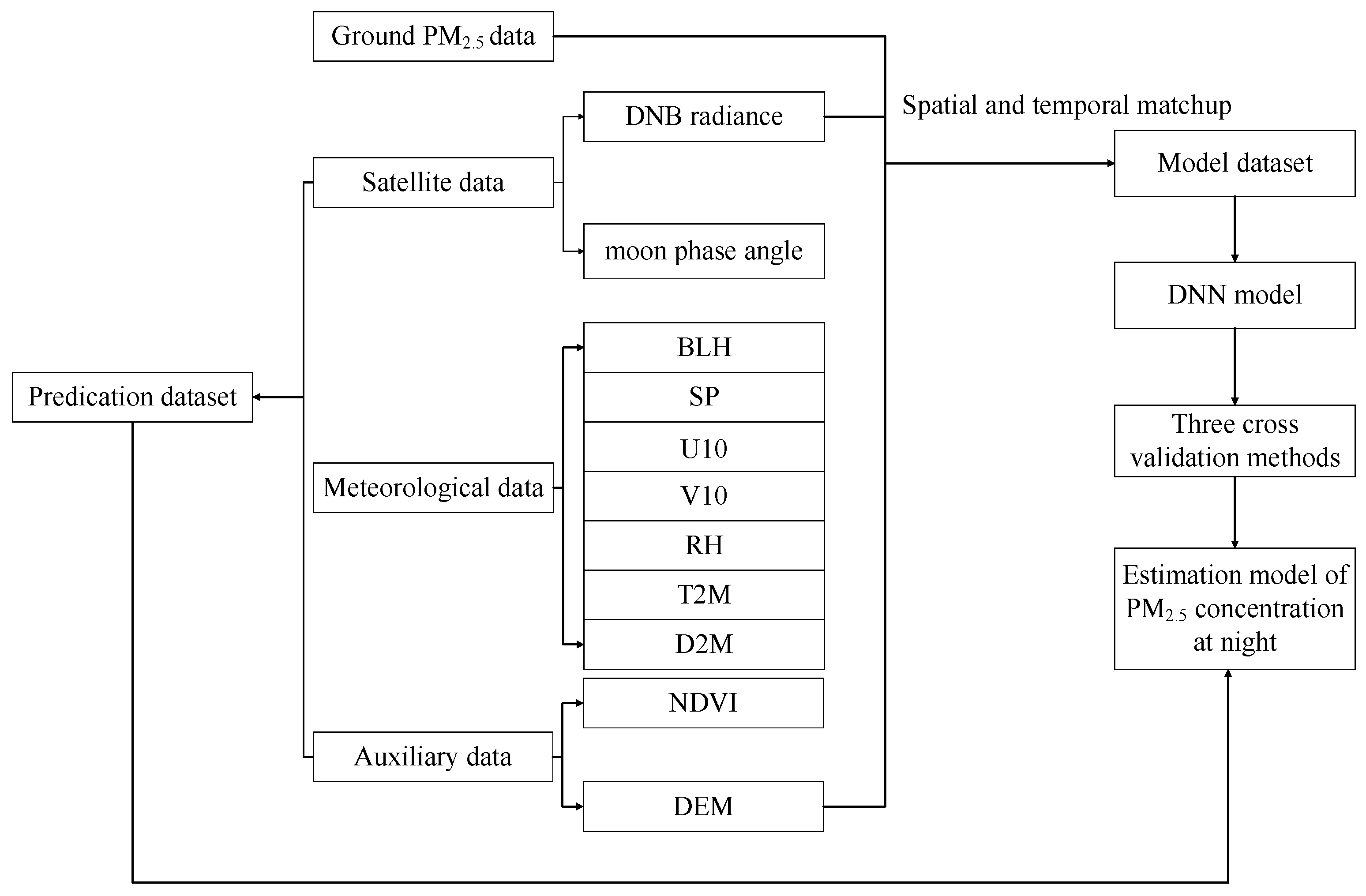
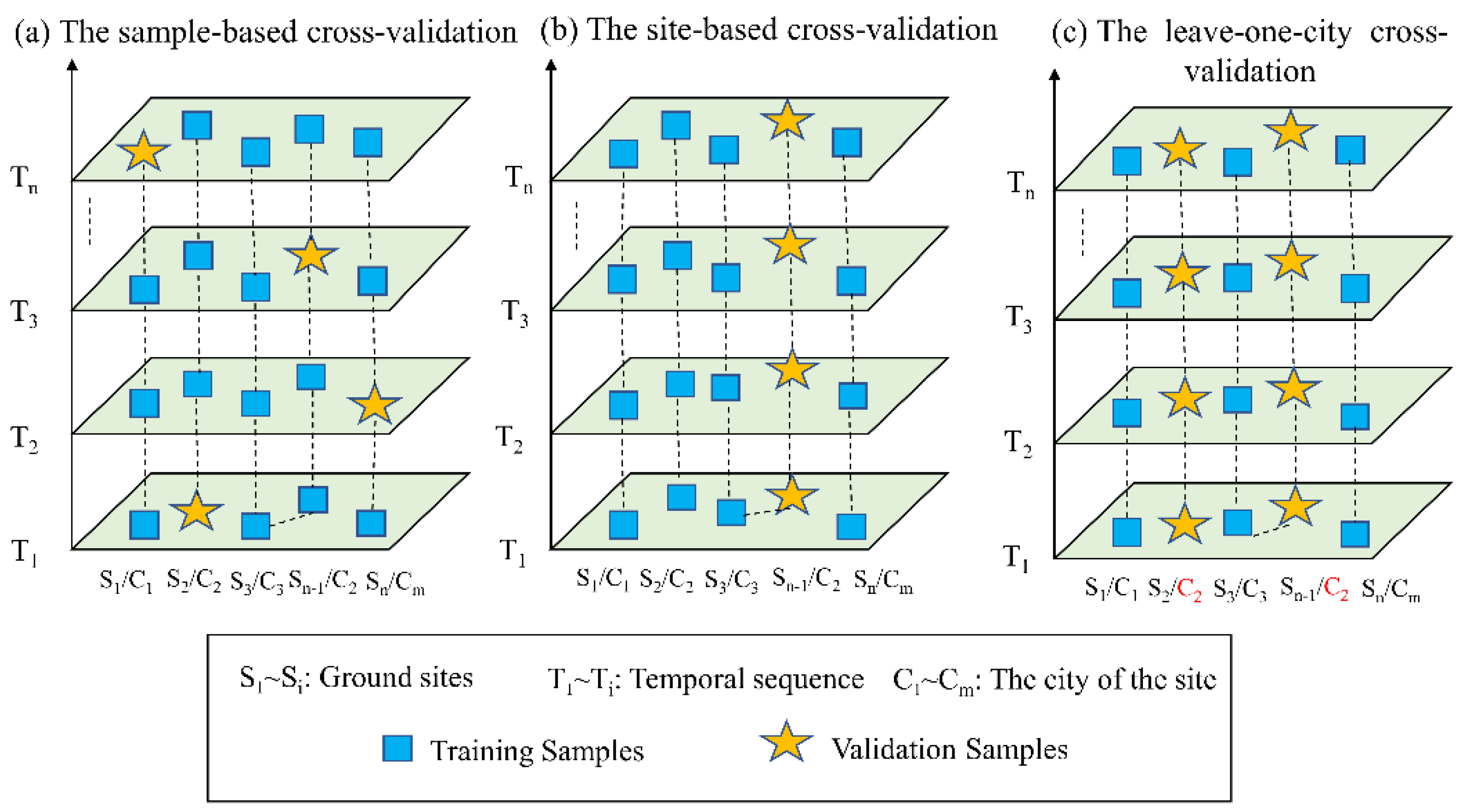
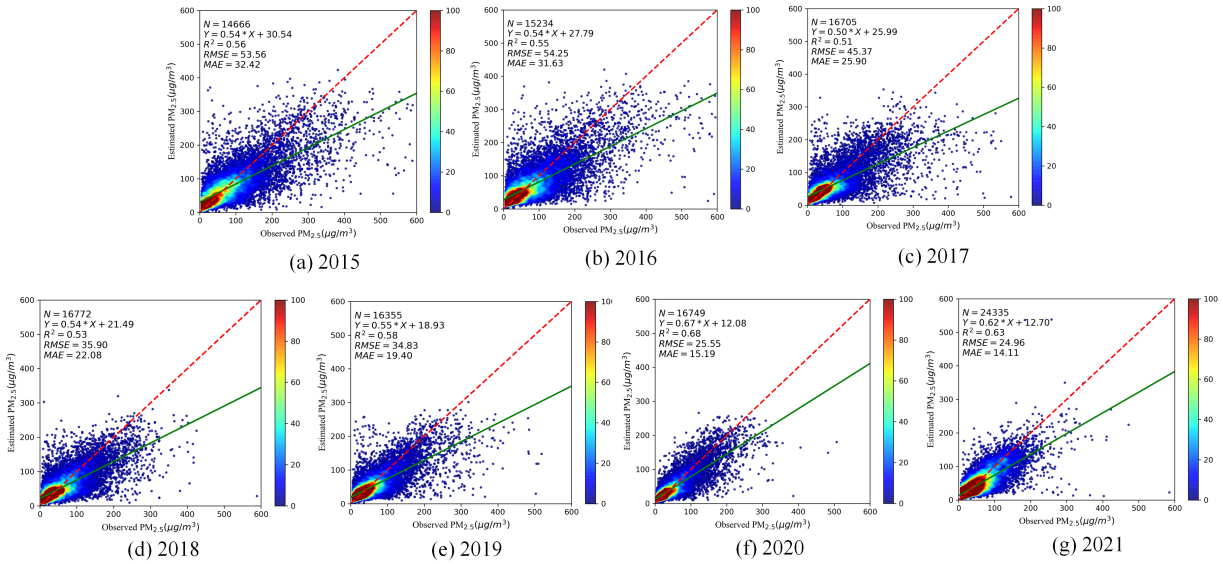

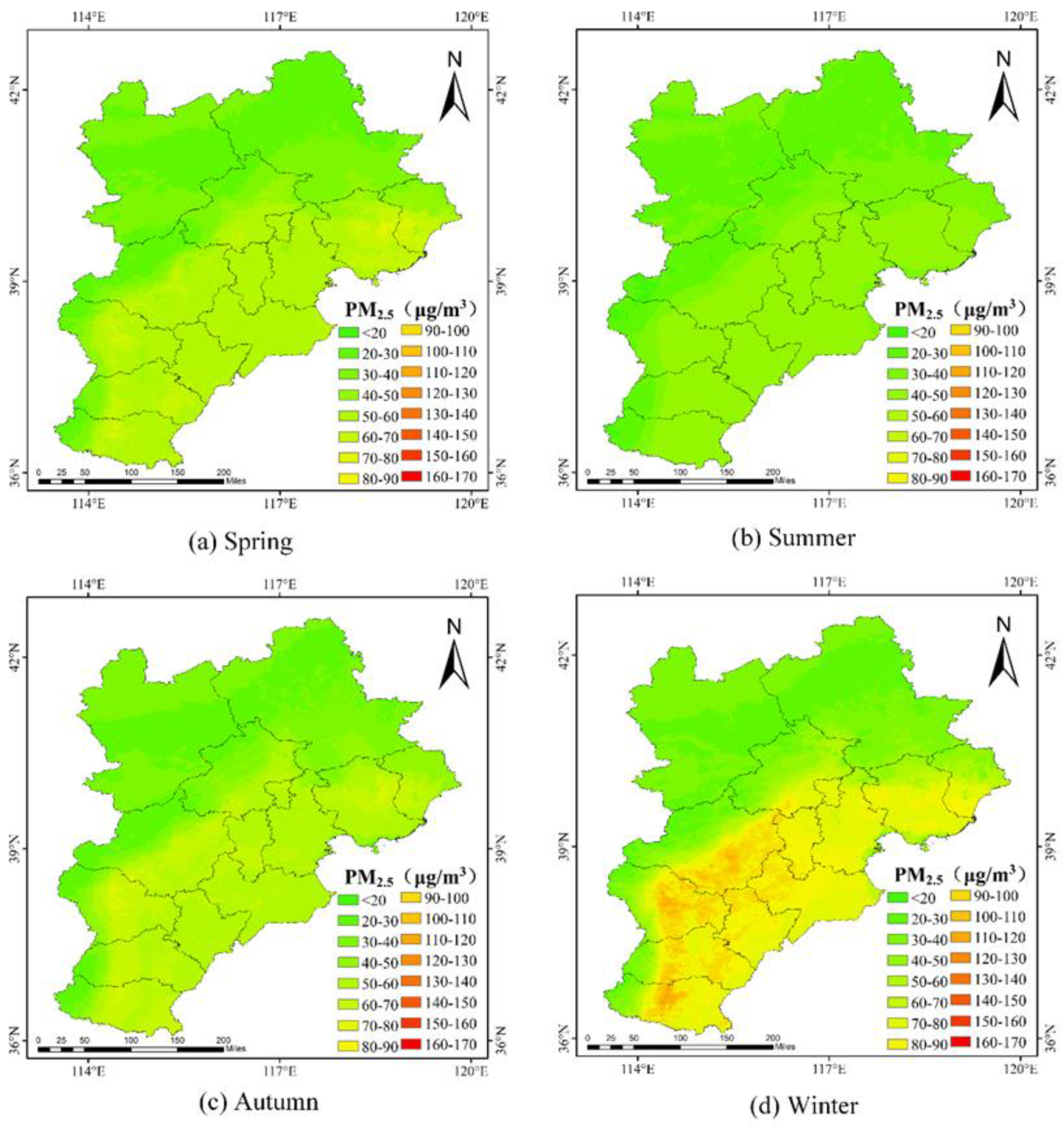
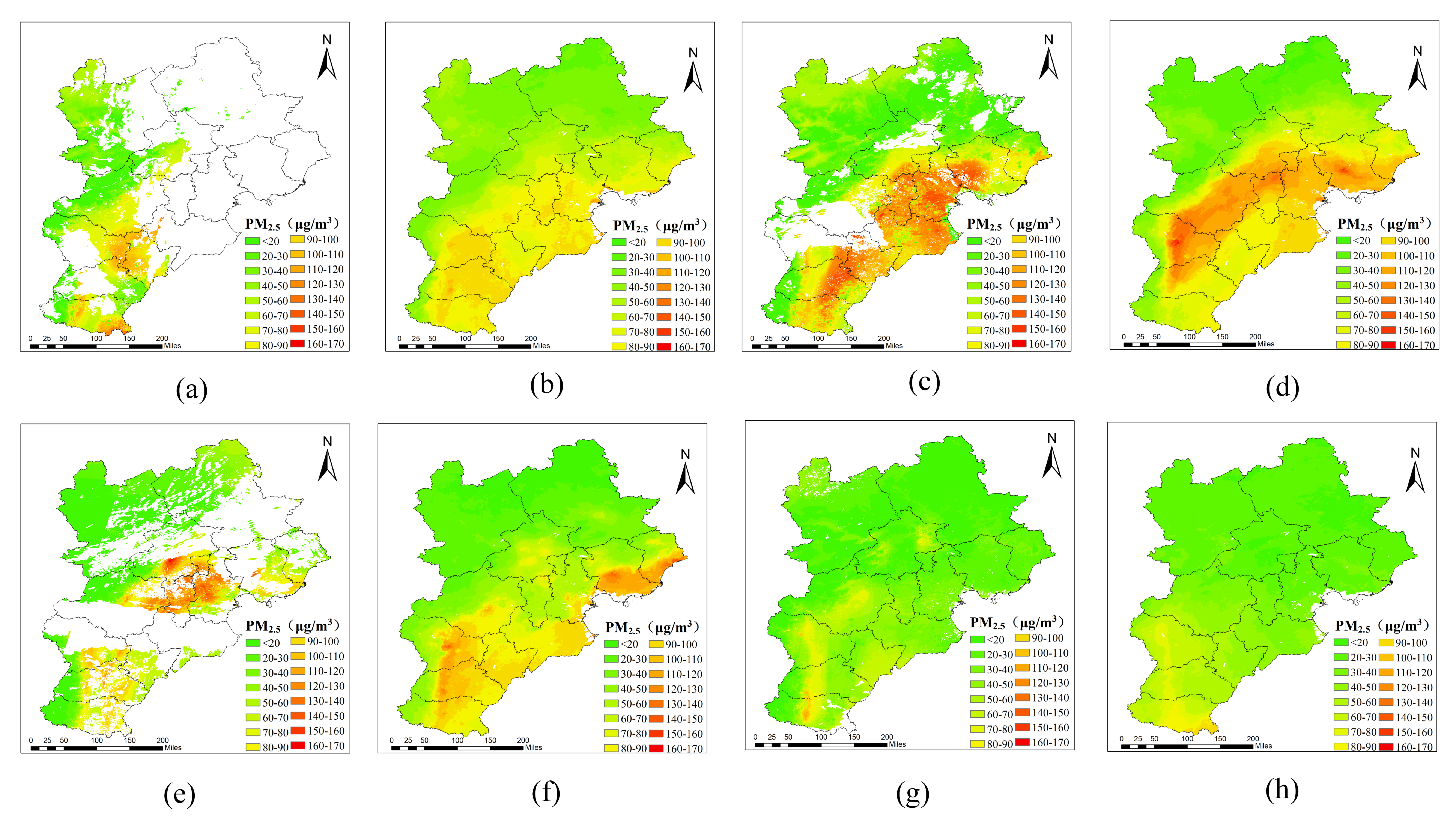
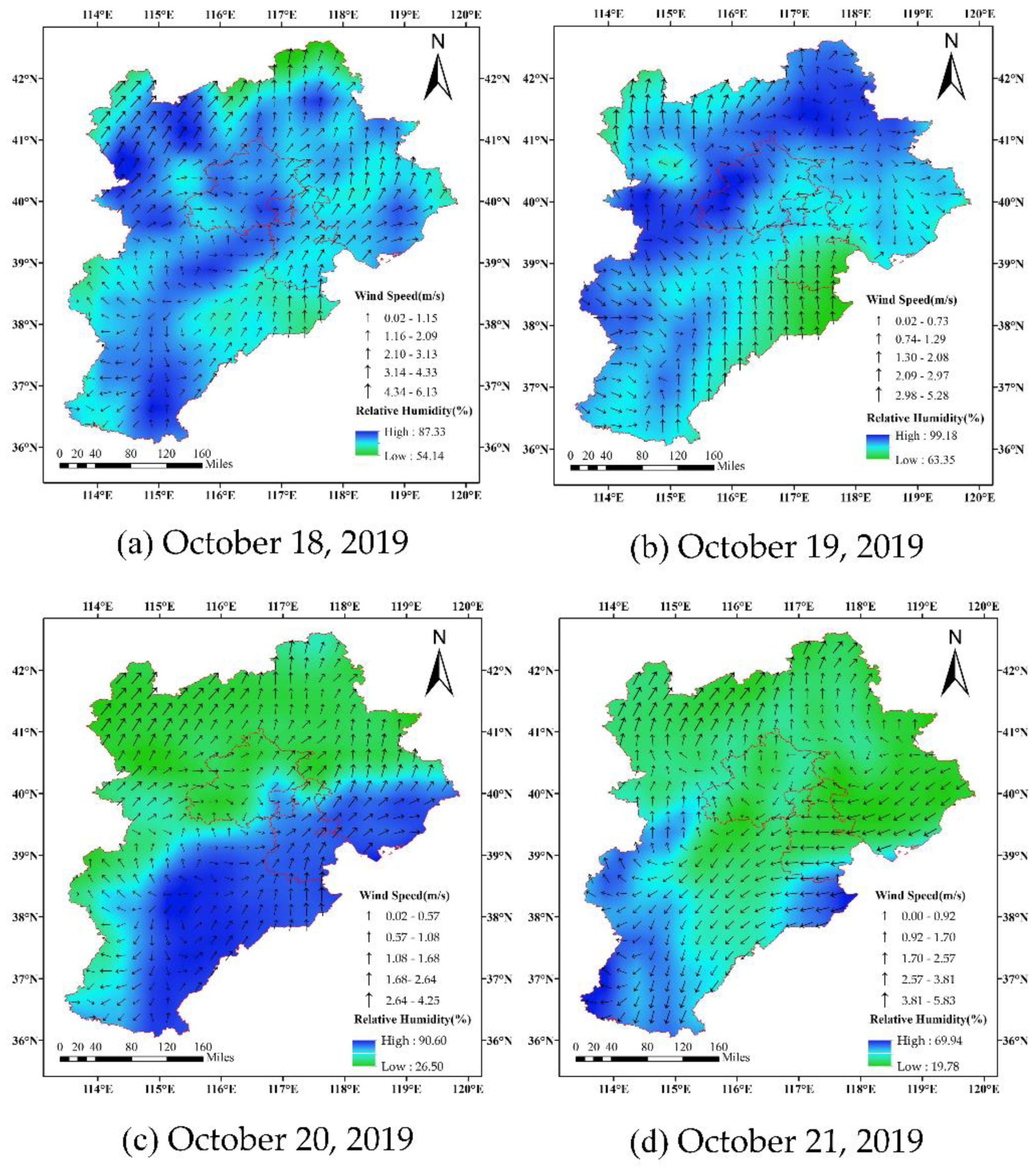
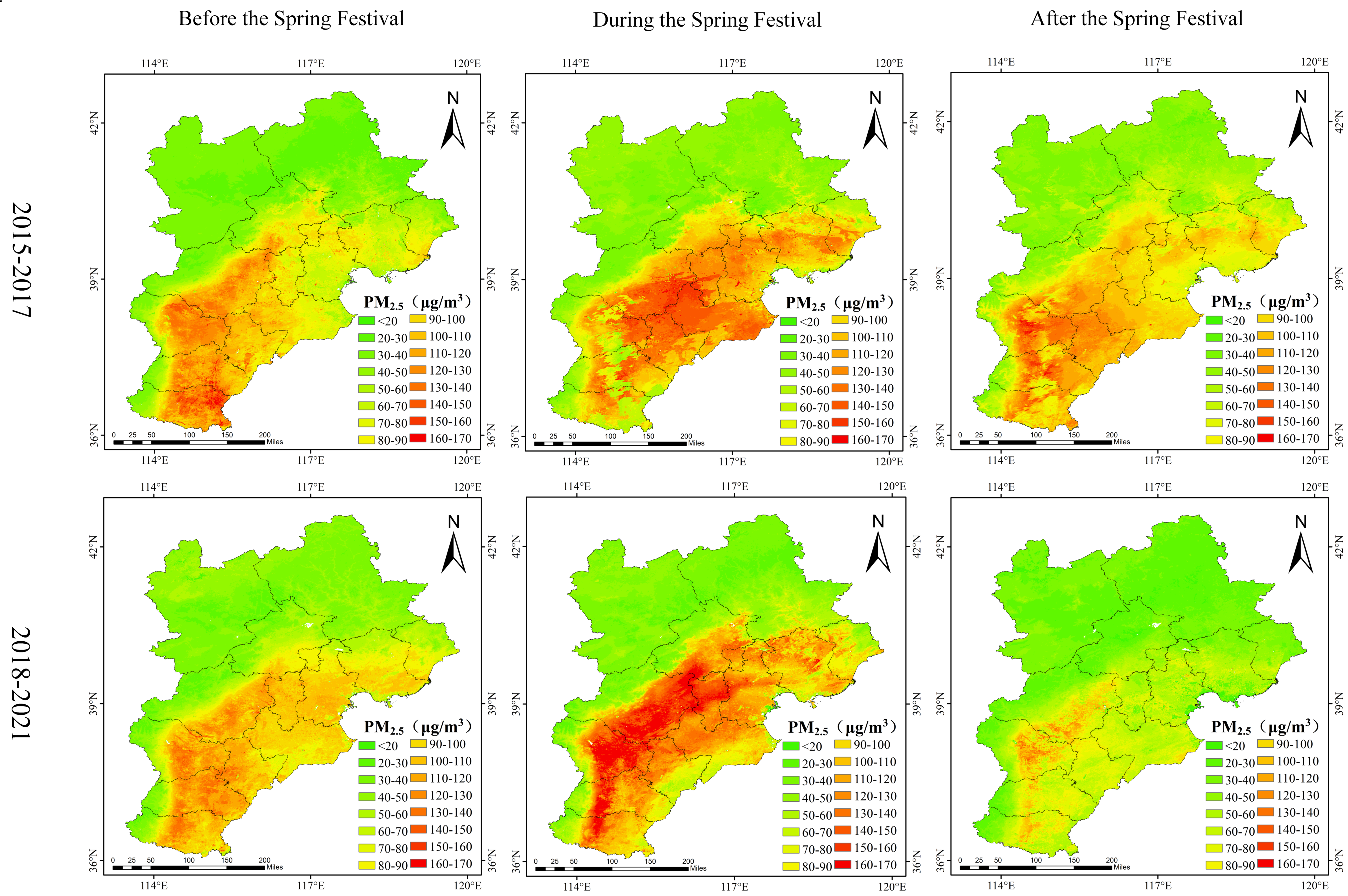

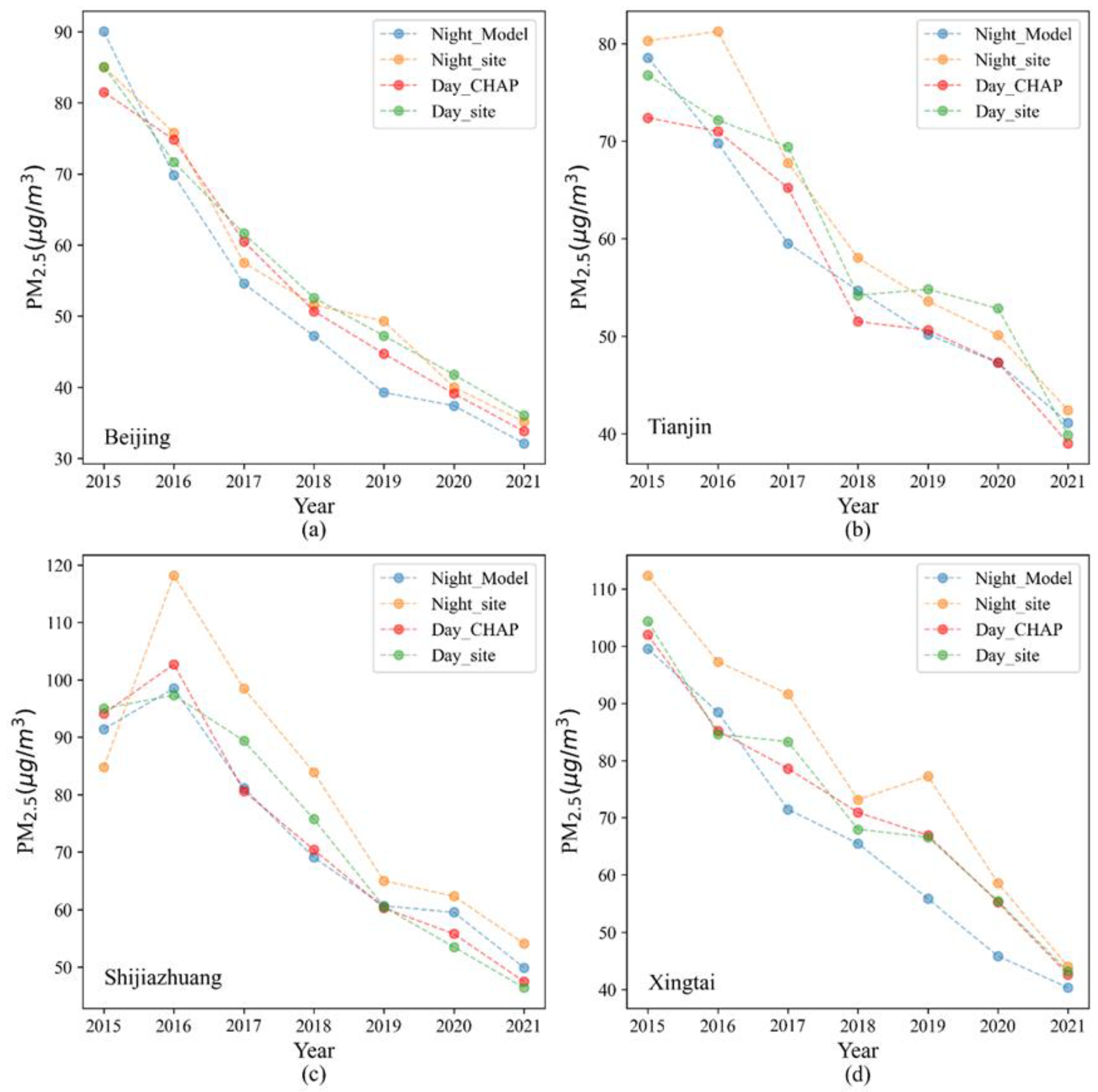
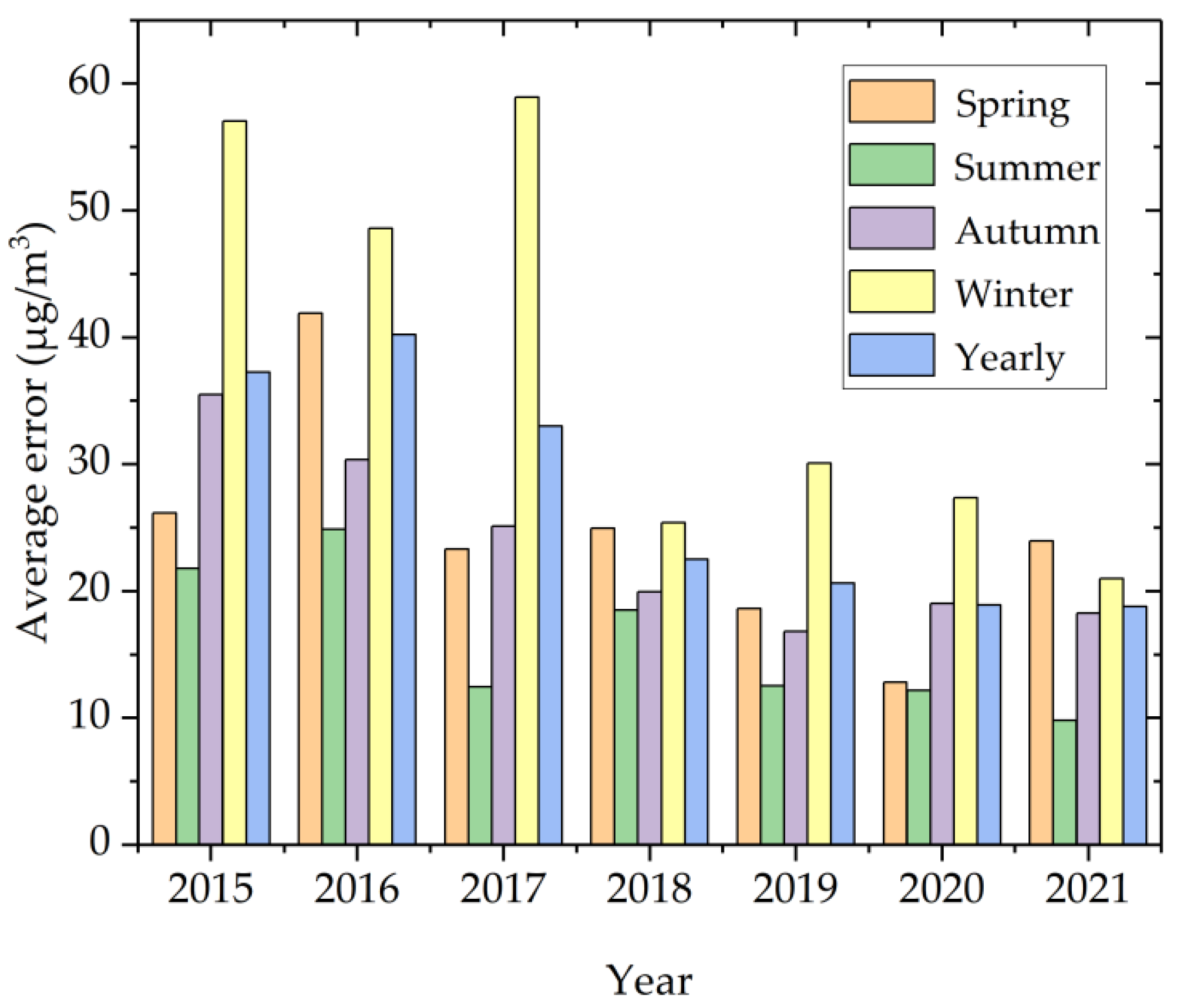
| Category | Data | Data Source | Units | Spatial Resolution | Temporal Resolution |
|---|---|---|---|---|---|
| Satellite data | DNB radiance | VNP46A1 | W/(sr·m2) | 500 m | Daily |
| moon phase angle | degree | ||||
| Meteorological data | BLH | ERA5 | m | 0.25° × 0.25° | Hourly |
| SP | Pa | ||||
| T2M | K | ||||
| D2M | K | ||||
| RH | % | ||||
| U10 | m/s | ||||
| V10 | m/s | ||||
| Auxiliary data | NDVI | MOD13A1 | - | 500 m | 16 Days |
| DEM | GMTED2010 | m | 900 m | - | |
| Ground PM2.5 data | PM2.5 | CNMEC | µg/m3 | - | Hourly |
| Input Variables | 2015 | 2016 | 2017 | 2018 | 2019 | 2020 | 2021 |
|---|---|---|---|---|---|---|---|
| Without DNB radiance | 0.55 | 0.53 | 0.50 | 0.52 | 0.56 | 0.66 | 0.61 |
| Without moon phase angle | 0.51 | 0.50 | 0.42 | 0.49 | 0.50 | 0.61 | 0.56 |
| Without BLH | 0.53 | 0.53 | 0.49 | 0.51 | 0.53 | 0.67 | 0.61 |
| Without D2M | 0.54 | 0.52 | 0.50 | 0.50 | 0.54 | 0.65 | 0.62 |
| Without RH | 0.53 | 0.50 | 0.46 | 0.50 | 0.54 | 0.63 | 0.59 |
| Without SP | 0.54 | 0.52 | 0.49 | 0.51 | 0.55 | 0.64 | 0.61 |
| Without T2M | 0.53 | 0.51 | 0.49 | 0.50 | 0.54 | 0.66 | 0.60 |
| Without U10 | 0.53 | 0.52 | 0.49 | 0.52 | 0.55 | 0.64 | 0.61 |
| Without V10 | 0.53 | 0.52 | 0.48 | 0.52 | 0.53 | 0.66 | 0.59 |
| Without NDVI | 0.55 | 0.54 | 0.50 | 0.53 | 0.57 | 0.68 | 0.62 |
| Without DEM | 0.53 | 0.52 | 0.50 | 0.52 | 0.56 | 0.67 | 0.62 |
| All 1 | 0.56 | 0.55 | 0.51 | 0.53 | 0.58 | 0.68 | 0.63 |
| Model | Numbers of Samples | Time Span | Spatial Resolution (m) | Region | R2 | RMSE (µg/m3) | Reference |
|---|---|---|---|---|---|---|---|
| MLR | 75 | 1 August 2012–30 October 2012 | 750 | Atlanta | 0.45 | 4.112 | [14] |
| SVM | 50 | March–May 2013 | 750 | Beijing | 0.9 | - | [42] |
| MLR | 488 | December–February 2012–2018 | 750 | Shanghai | 0.77 | 19.21 | [43] |
| RF | - | September–December 2020 | 500 | Nanjing | 0.81 | - | [12] |
| BP | 198 | March–May 2013 | 750 | Beijing | 0.83 | 12.02 | [13] |
| SADBN | 13,393 | 13–23 February 2013; 4–12 February 2016; and 24 January to 1 February 2017; and 12–22 February 2018 | 750 | China | 0.89 | 19.94 | [44] |
| DNN | 120,816 | 2015−2021 | 500 | BTH | 0.51–0.68 | 54.25–12.11 | This study |
Disclaimer/Publisher’s Note: The statements, opinions and data contained in all publications are solely those of the individual author(s) and contributor(s) and not of MDPI and/or the editor(s). MDPI and/or the editor(s) disclaim responsibility for any injury to people or property resulting from any ideas, methods, instructions or products referred to in the content. |
© 2023 by the authors. Licensee MDPI, Basel, Switzerland. This article is an open access article distributed under the terms and conditions of the Creative Commons Attribution (CC BY) license (https://creativecommons.org/licenses/by/4.0/).
Share and Cite
Ma, Y.; Zhang, W.; Chen, X.; Zhang, L.; Liu, Q. High Spatial Resolution Nighttime PM2.5 Datasets in the Beijing–Tianjin–Hebei Region from 2015 to 2021 Using VIIRS/DNB and Deep Learning Model. Remote Sens. 2023, 15, 4271. https://doi.org/10.3390/rs15174271
Ma Y, Zhang W, Chen X, Zhang L, Liu Q. High Spatial Resolution Nighttime PM2.5 Datasets in the Beijing–Tianjin–Hebei Region from 2015 to 2021 Using VIIRS/DNB and Deep Learning Model. Remote Sensing. 2023; 15(17):4271. https://doi.org/10.3390/rs15174271
Chicago/Turabian StyleMa, Yu, Wenhao Zhang, Xiaoyang Chen, Lili Zhang, and Qiyue Liu. 2023. "High Spatial Resolution Nighttime PM2.5 Datasets in the Beijing–Tianjin–Hebei Region from 2015 to 2021 Using VIIRS/DNB and Deep Learning Model" Remote Sensing 15, no. 17: 4271. https://doi.org/10.3390/rs15174271
APA StyleMa, Y., Zhang, W., Chen, X., Zhang, L., & Liu, Q. (2023). High Spatial Resolution Nighttime PM2.5 Datasets in the Beijing–Tianjin–Hebei Region from 2015 to 2021 Using VIIRS/DNB and Deep Learning Model. Remote Sensing, 15(17), 4271. https://doi.org/10.3390/rs15174271







